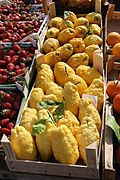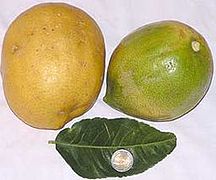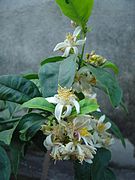Citron
| Citron Citrus medica | |
|---|---|
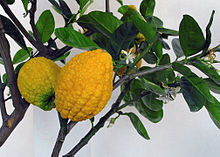
| |
| Scientific classification | |
| Kingdom: | |
| (unranked): | |
| (unranked): | |
| (unranked): | |
| Order: | |
| Family: | |
| Genus: | |
| Species: | C. medica
|
| Binomial name | |
| Citrus medica | |
The citron is a large fragrant citrus fruit with a thick rind, botanically classified as Citrus medica[1] by both the Swingle and Tanaka botanical name systems. It is one of the four original citrus fruits (the others being pomelo, mandarin and papeda), from which all other citrus types developed through natural hybrid speciation or artificial hybridization.[2]
Etymology
The fruit's English name "citron" derives ultimately from Latin, citrus, which is also the origin of the genus name.
Other languages
A source of confusion is that citron or similar words in French, Lithuanian, Hungarian, Finnish, Latvian, the West Slavic languages, and all Germanic languages but English are false friends, as they refer to the lemon. Indeed, into the 16th century, the English name citron included the lemon and perhaps the lime as well.[3][failed verification] In Italian it is known as a cedro.
In Persian languages, it is called Turunj, as against "Naranj" (bitter orange); both names borrowed by Arabic and introduced into Spain and Portugal after their occupation by the Muslims in AD 711, whence it became the source of the name orange. In Syria it is called Kabbad;[4] in Japanese it is called Bushukan (maybe referring only to the fingered varieties).[5]
Uses
Culinary

While the lemon or orange are peeled to consume their pulpy and juicy segments, the citron's pulp is dry, containing a small quantity of insipid juice, if any. The main content of a citron fruit is the thick white rind, which adheres to the segments and cannot be separated from them easily. The citron gets halved and depulped, then its rind (the thicker the better) is cut in pieces, cooked in sugar syrup, and used as a spoon sweet, in Greek known as "kitro glyko" (κίτρο γλυκό), or it is diced and caramelized with sugar and used as a confection in cakes.

In Samoa a refreshing drink called "vai tipolo" is made from squeezed juice. It is also added to a raw fish dish called "oka" and to a variation of palusami or luáu.
Today the citron is used for the fragrance or zest of its flavedo, but the most important part is still the inner rind (known as pith or albedo), which is a fairly important article in international trade and is widely employed in the food industry as succade,[6][7][8] as it is known when it is candied in sugar.
The dozens of varieties of citron are collectively known as Lebu in Bangladesh, where it is the primary citrus fruit.
In Iran, the citron's thick white rind is used to make jam; in Pakistan the fruit is used to make jam but is also pickled; in South Indian cuisine, some varieties of citron (collectively referred to as "Narthangai" in Tamil) are widely used in pickles and preserves. In Kutch, Gujarat, It is used to make pickle, where in entire slices of fruits are salted, dried and mixed with jaggery and spices to make sweet spicy pickle.[9] In the United States, citron is an important ingredient in holiday fruit cakes.
Medicinal
From ancient through medieval times, the citron was used mainly for medical purposes: to combat seasickness, pulmonary troubles, intestinal ailments, scurvy and other disorders. The essential oil of the flavedo (the outermost, pigmented layer of rind) was also regarded as an antibiotic. Citron juice with wine was considered an effective antidote to poison, as Theophrastus reported. In the Ayurvedic system of medicine, the juice is still used for treating conditions like nausea, vomiting, and excessive thirst.
The juice of the citron has a high Vitamin C content and used medicinally as an anthelmintic, appetizer, tonic, in cough, rheumatism, vomiting, flatulence, haemorrhoids, skin diseases and weak eyesight.[10]
There is an increasing market for the citron for the soluble fiber (pectin) found in its thick albedo.[11]
Religious
In Judaism
The citron is used by Jews (the word for it in Hebrew is etrog) for a religious ritual during the Jewish harvest holiday of Sukkot, the Feast of Tabernacles; therefore, it is considered to be a Jewish symbol which is found on various Hebrew antiques and archaeological findings.[12] Citrons used for ritual purposes cannot be grown by grafting branches.

In Buddhism
A variety of citron native to China has sections that separate into finger-like parts and is used as an offering in Buddhist temples.
Perfumery
For many centuries, citron's fragrant essential oil has been used in perfumery, the same oil that was used medicinally for its antibiotic properties. Its major constituent is limonene.[13]
Description and variation

Fruit
The citron fruit is usually ovate or oblong, narrowing towards the stylar end. However, the citron's fruit shape is highly variable, due to the large quantity of albedo, which forms independently according to the fruits' position on the tree, twig orientation, and many other factors. The rind is leathery, furrowed, and adherent. The inner portion is thick, white and hard; the outer is uniformly thin and very fragrant. The pulp is usually acidic, but also can be sweet, and even pulpless varieties are found.
Most citron varieties contain a large number of monoembryonic seeds. They are white, with dark innercoats and red-purplish chalazal spots for the acidic varieties, and colorless for the sweet ones. Some citron varieties are also distinct, having persistent styles, that do not fall off after fecundation. Those are usually promoted for etrog use.
Some citrons have medium-sized oil bubbles at the outer surface, medially distant to each other. Some varieties are ribbed and faintly warted on the outer surface. There is also a fingered citron variety called Buddha's hand.
The color varies from green, when unripe, to a yellow-orange when overripe. The citron does not fall off the tree and can reach 8–10 pounds (4–5 kg) if not picked before fully mature.[14][15] However, they should be picked before the winter, as the branches might bend or break to the ground, and may cause numerous fungal diseases for the tree.
Plant

Citrus medica is a slow-growing shrub or small tree that reaches a height of about 8 to 15 ft (2 to 5 m). It has irregular straggling branches and stiff twigs and long spines at the leaf axils. The evergreen leaves are green and lemon-scented with slightly serrate edges, ovate-lanceolate or ovate elliptic 2.5 to 7.0 inches long. Petioles are usually wingless or with minor wings. The clustered flowers of the acidic varieties are purplish tinted from outside, but the sweet ones are white-yellowish.
| Citron varieties |
|---|
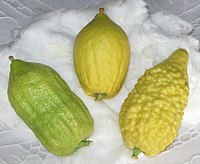 |
| Acidic-pulp varieties |
| Non-acidic varieties |
| Pulpless varieties |
| Citron hybrids |
| Related articles |
The citron tree is very vigorous with almost no dormancy, blooming several times a year, and is therefore fragile and extremely sensitive to frost.[16]
Varieties and hybrids
The acidic varieties include the Florentine and Diamante citron from Italy, the Greek citron and the Balady citron from Israel.[17] The sweet varieties include the Corsican and Moroccan citrons. Between the pulpless are also some fingered varieties and the Yemenite citron.
There are also a number of citron hybrids; for example, ponderosa lemon, the lumia and rhobs el Arsa are known citron hybrids, some are claiming that even the Florentine citron is not pure citron, but a citron hybrid.
Origin and distribution
Despite the variation among the cultivars, authorities agree the citron is an old and original species. There is molecular evidence that all other cultivated citrus species arose by hybridization among four ancestral types, which are the citron, pomelo, mandarin and some papedas. The citron is believed to be the purest of them all, since it is usually fertilized by self-pollination, and is therefore generally considered to be a male parent of any citrus hybrid rather than a female one.[15][18][19][20][21][22]
Today, authorities agree that all citrus species are native to Southeast Asia, where they are found wild and in an uncultivated form. The story of how they spread to the Mediterranean has been reported by Francesco Calabrese,[23] Henri Chapot,[24] Samuel Tolkowsky,[25] Elizabetta Nicolisi,[26] and others.[6][15][27][28]
The citron could also be native to India where it borders on Burma, in valleys at the foot of the Himalayas, and in the Indian Western Ghats.[29][failed verification][30] It is thought that by the time of Theophrastus, the citron was mostly cultivated in the Persian Gulf on its way to the Mediterranean basin, where it was cultivated during the later centuries in different areas as described by Erich Isaac.[31] Many mention the role of Alexander the Great and his armies as they attacked Persia and what is today Pakistan, as being responsible for the spread of the citron westward, reaching the European countries such as Macedonia and Italy.[6][28][32][33][34][35][36][37]
Antiquity
Leviticus mentions the "fruit of the tree hadar" as being required for ritual use during the Feast of Tabernacles (Lev. 23:40). According to Rabbinical tradition, the "fruit of the tree hadar" refers to the citron, which the Israelites brought to Israel from their exile in Egypt, where the Egyptologist and archaeologist Victor Loret claimed to have identified it depicted on the walls of the botanical garden at the Karnak Temple, which dates back to the time of Thutmosis III, approximately 3,000 years ago.[38]
The citron has been cultivated since ancient times, predating the cultivation of other citrus species.[39]
Theophrastus
The following description on citron was given by Theophrastus[40]

In the east and south there are special plants... i.e. in Media and Persia there are many types of fruit, between them there is a fruit called Median or Persian Apple. The tree has a leaf similar to and almost identical with that of the andrachn (Arbutus andrachne L.), but has thorns like those of the apios (the wild pear, Pyrus amygdaliformis Vill.) or the firethorn (Cotoneaster pyracantha Spach.), except that they are white, smooth, sharp and strong. The fruit is not eaten, but is very fragrant, as is also the leaf of the tree; and the fruit is put among clothes, it keeps them from being moth-eaten. It is also useful when one has drunk deadly poison, for when it is administered in wine; it upsets the stomach and brings up the poison. It is also useful to improve the breath, for if one boils the inner part of the fruit in a dish or squeezes it into the mouth in some other medium, it makes the breath more pleasant.
The seed is removed from the fruit and sown in the spring in carefully tilled beds, and it is watered every fourth or fifth day. As soon the plant is strong it is transplanted, also in the spring, to a soft, well watered site, where the soil is not very fine, for it prefers such places.
And it bears its fruit at all seasons, for when some have gathered, the flower of the others is on the tree and is ripening others. Of the flowers I have said[41] those that have a sort of distaff [meaning the pistil] projecting from the middle are fertile, while those that do not have this are sterile. It is also sown, like date palms, in pots punctured with holes.
This tree, as has been remarked, grows in Media and Persia.
Pliny the Elder
Citron was also described by Pliny the Elder, who called it nata Assyria malus. The following is from his book Natural History:
There is another tree also with the same name of "citrus," and bears a fruit that is held by some persons in particular dislike for its smell and remarkable bitterness; while, on the other hand, there are some who esteem it very highly. This tree is used as an ornament to houses; it requires, however, no further description.[42]
The citron tree, called the Assyrian, and by some the Median apple, is an antidote against poisons. The leaf is similar to that of the arbute, except that it has small prickles running across it. As to the fruit, it is never eaten, but it is remarkable for its extremely powerful smell, which is the case, also, with the leaves; indeed, the odour is so strong, that it will penetrate clothes, when they are once impregnated with it, and hence it is very useful in repelling the attacks of noxious insects.
The tree bears fruit at all seasons of the year; while some is falling off, other fruit is ripening, and other, again, just bursting into birth. Various nations have attempted to naturalize this tree among them, for the sake of its medical properties, by planting it in pots of clay, with holes drilled in them, for the purpose of introducing the air to the roots; and I would here remark, once for all, that it is as well to remember that the best plan is to pack all slips of trees that have to be carried to any distance, as close together as they can possibly be placed.
It has been found, however, that this tree will grow nowhere except in Media or Persia. It is this fruit, the pips of which, as we have already mentioned, the Parthian grandees employ in seasoning their ragouts, as being peculiarly conducive to the sweetening of the breath. We find no other tree very highly commended that is produced in Media.[43]
Citrons, either the pulp of them or the pips, are taken in wine as an antidote to poisons. A decoction of citrons, or the juice extracted from them, is used as a gargle to impart sweetness to the breath. The pips of this fruit are recommended for pregnant women to chew when affected with qualmishness. Citrons are good, also, for a weak stomach, but it is not easy to eat them except with vinegar.[44]
See also
Gallery
-
In a German market, for culinary use
-
In fruit market of Italy
-
Naxos citrons and leaf
-
A wild citron in India
-
Citron flowers
-
Unknown citron type in pot
Notes
- ^ Chisholm, Hugh, ed. (1911). . Encyclopædia Britannica. Vol. 6 (11th ed.). Cambridge University Press. p. 398.
- ^ Klein, J. (2014). "Citron Cultivation, Production and Uses in the Mediterranean Region". In Z. Yaniv; N. Dudai (eds.). Medicinal and Aromatic Plants of the Middle-East. Vol. 2. Springer Netherlands. pp. 199–214. doi:10.1007/978-94-017-9276-9_10.
- ^ "Home : Oxford English Dictionary". oed.com.
- ^ "Citrus medica" (PDF). plantlives.com.
- ^ "Buddha". University of California, Riverside.
- ^ a b c "Citron: Citrus medica Linn". Purdue University.
- ^ The Citron in Crete Archived September 30, 2007, at the Wayback Machine
- ^ "Candied Citron". Vine Tree Orchards.
- ^ "Bijora Pickle". Jain World.
- ^ "Matulunga (Citrus medica)". frlht.org. Archived from the original on 2013-12-24.
{{cite web}}: Unknown parameter|deadurl=ignored (|url-status=suggested) (help) - ^ Dalia A. Abdul. "Preparation and Characterization of Pectin from Peel of Kabad (Citrus Medica) Fruit in Sulaimani City, Iraqi Kurdistan Region" (PDF). International Journal of Current Research in Chemistry and Pharmaceutical Sciences. 1 (7): 142–146.
- Ratchada Tangwongchai; K. Lerkchaiyaphum; Kasem Nantachai; T. Rojanakorn (November 2006). "Pectin extraction from Citron peel (Citrus medica Linn.) and its use in food system". Songklanakarin Journal of Science and Technology. 28 (6): 6 – via ResearchGate.
- Frederick Hardy (1924). "The Extraction of Pectin from the Fruit Rind of the Lime (Citrus medica acida)". Biochemistry Journal. 18 (2): 283–290. doi:10.1042/bj0180283. PMC 1259415. PMID 16743304.
- Scholarly Document Archived July 26, 2011, at the Wayback Machine
- "Nutritional compostions comprising a soluble viscous fiber in a solid crisp matrix: United States Patent Application 20060078593". Free Patents Online.
- Jan Ridgely. "Facts on fibre". Peak of Health.
- See also FiberStar and NYU Langone Medical Center Archived October 3, 2014, at the Wayback Machine
- ^ See Etrog
- ^ Inouye, S.; Takizawa, T.; Yamaguchi, H. (2001). "Antibacterial activity of essential oils and their major constituents against respiratory tract pathogens by gaseous contact". Journal of Antimicrobial Chemotherapy. 47 (5): 565–573. doi:10.1093/jac/47.5.565. PMID 11328766.
- ^ Un curieux Cedrat marocain, Chapot 1950.
- ^ a b c The Search for the Authentic Citron: Historic and Genetic Analysis; HortScience 40(7):1963–1968. 2005 Archived September 21, 2008, at the Wayback Machine
- ^ "Website Disabled". University of California, Riverside. Archived from the original on 2008-03-08.
{{cite web}}: Unknown parameter|deadurl=ignored (|url-status=suggested) (help) - ^ Meena, Ajay Kumar; Kandale, Ajit; Rao, M. M.; Panda, P.; Reddy, Govind (2011). "A review on citron-pharmacognosy, phytochemistry and medicinal uses" (PDF). The Journal of Pharmacy. 2 (1): 14–20.
- ^ E. Nicolosi; Z. N. Deng; A. Gentile; S. La Malfa; G. Continella; E. Tribulato (June 2000). "Citrus phylogeny and genetic origin of important species as investigated by molecular markers". Theoretical and Applied Genetics. 100 (8): 1155–1166. doi:10.1007/s001220051419.
- ^ Noelle A. Barkley; Mikeal L. Roose; Robert R. Krueger; Claire T. Federici (May 2006). "Assessing genetic diversity and population structure in a citrus germplasm collection utilizing simple sequence repeat markers (SSRs)". Theoretical and Applied Genetics. 112 (8): 1519–1531. doi:10.1007/s00122-006-0255-9. PMID 16699791.
- ^ Asad Asadi Abkenar; Shiro Isshiki; Yosuke Tashiro (1 November 2004). "Phylogenetic relationships in the 'true citrus fruit trees' revealed by PCR-RFLP analysis of cpDNA". Scientia Horticulturae. 102 (2): 233–242. doi:10.1016/j.scienta.2004.01.003.
- ^ C. A. Krug (June 1943). "Chromosome Numbers in the Subfamily Aurantioideae with Special Reference to the Genus Citrus". Botanical Gazette. 104 (4): 602–611. doi:10.1086/335173. JSTOR 2472147.
- ^ R. Carvalho; W. S. Soares Filho; A. C. Brasileiro-Vidal; M. Guerra (March 2005). "The relationships among lemons, limes and citron: a chromosomal comparison". Cytogenetic and Genome Research. 109 (1–3): 276–282. doi:10.1159/000082410.
- ^ Calabrese, La favolosa storia degli agrumi. L'EPOS, 1998, Palerno Italy. English translation in Francesco Calabrese (2003). "Origin and history". In Giovanni Dugo; Angelo Di Giacomo (eds.). Citrus: The Citrus Genus. CRC Press. p. 5. ISBN 9780203216613.
- ^ Capot, "The citrus plant", p. 6-13. in: Citrus. Ciba-Geigy Agrochemicals Tech. Monogr.4. Ciba-Geigy Ltd., 1975, Basle, Switzerland.
- ^ Tolkowsky, Hesperides (1938). A history of the culture and use of citrus fruits. London: John Bale, Sons and Curnow. p. 371.
- ^ Iqrar A. Khan, ed. (2007). Citrus Genetics, Breeding and Biotechnology. CABI. p. 21. ISBN 9781845931933.
- ^ "Website Disabled". University of California, Riverside. Archived from the original on 2007-08-08.
{{cite web}}: Unknown parameter|deadurl=ignored (|url-status=suggested) (help) - ^ a b Frederick J. Simoons (1990). Food in China: a cultural and historical inquiry. CRC Press. p. 200. ISBN 9780849388040.
- ^ "The Garden – Sir Joseph Hooker. Flora of British India, i. 514".
- ^ Country Report to the FAO International Technical Conference on Plant Genetic Resources (Leipzig, 1996); Prepared by: Nepal Agricultural Research Council; Kathmandu, June 1995; CHAPTER 2.2 Archived April 10, 2008, at the Wayback Machine
- ^ Erich Isaac (January 1959). "The Citron in the Mediterranean: a study in religious influences". Economic Geography. 35 (1): 71–78. doi:10.2307/142080. JSTOR 142080.
- ^ "ethrog". University of California, Riverside.
- ^ Marion Eugene Ensminger; Audrey H. Ensminger (1993). Foods & Nutrition Encyclopedia. Vol. volume 1 (2nd ed.). CRC Press. p. 424. ISBN 9780849389818.
{{cite book}}:|volume=has extra text (help) - ^ Francesco Calabrese (2003). "Origin and history". In Giovanni Dugo; Angelo Di Giacomo (eds.). Citrus: The Citrus Genus. CRC Press. p. 4. ISBN 9780203216613.
- ^ Biology of Citrus[dead link]
- ^ H. Harold Hume (2007). Citrus Fruits and Their Culture. Read Books. p. 59. ISBN 9781406781564.
- ^ Emanuel Bonavia (1888). The Cultivated Oranges and Lemons, Etc. of India and Ceylon. W. H. Allen. p. 255.
- ^ "Scientific Committee, March 28, 1893: The Antiquity of the Citron in Egypt". Journal of the Royal Horticultural Society. 16.
- ^ Ramón-Laca, L. (Winter 2003). "The Introduction of Cultivated Citrus to Europe via Northern Africa and the Iberian Peninsula". Economic Botany. 57 (4): 502–514. doi:10.1663/0013-0001(2003)057[0502:tiocct]2.0.co;2.
- ^ Historia plantarum 4.4.2-3 (exc. Athenaeus Deipnosophistae 3.83.d-f); cf. Vergil Georgics 2.126-135; Pliny Naturalis historia 12.15,16.
- ^ Historia plantarum 1.13.4.
- ^ "Chap. 31.—The Citron-Tree". Perseus Digital Library. Tufts University. excerpting from John Bostock; H.T. Riley,, eds. (1855). The Natural History. Pliny the Elder. London: Taylor and Francis.
{{cite book}}: CS1 maint: extra punctuation (link) - ^ "Pliny the Elder, The Natural History, Book XII. The Natural History of Trees, Chap. 7. (3.)—How the Citron Is Planted". Tufts University.
- ^ "Pliny the Elder, The Natural History, Book XXIII. The Remedies Derived from the Cultivated Trees., Chap. 56.—Citrons: Five Observations upon Them". Tufts University.
References
- H. Harold Hume, Citrus Fruits and Their Culture
- Richard S. Barnett, All Kinds of Scented Wood
- Frederick J. Simoons, Food in China: A Cultural and Historical Inquiry
- Pinhas Spiegel-Roy, Eliezer E. Goldschmidt, Biology of Citrus
- Hugh Chisholm, ed., The Encyclopædia Britannica: A Dictionary of Arts, Sciences, Literature ...
- Citrus: The Genus Citrus By Giovanni Dugo, Angelo Di Giacomo
- Encyclopædia Britannica: A Dictionary of Arts, Sciences, Literature and General Information
- G. S. Nijjar, "Fruit Breeding in India"
- Proceedings, Google Book Search
- A Dictionary of Greek and Roman Culture
- International Standard Bible Encyclopedia: A-D By Geoffrey William Bromiley
- Allen Susser, The Great Citrus Book: A Guide With Recipes
- Citrus: The Genus Citrus By Giovanni Dugo, Angelo Di Giacomo - "Peel confection and candying"
- Penny Cyclopaedia of the Society for the Diffusion of Useful Knowledge
- Alphonse de Candolle, Origin of Cultivated Plants
- Evyatar Marienberg and David Carpenter, The Stealing of the 'Apple of Eve' from the 13th century Synagogue of Winchester, Henri III Fine Rolls Project, Fine of the Month: December 2011
External links
- USDA Plants Profile – Citrus medica
- "Citron" Purdue University
- Citrus Pages
- University of California- "Citrus Diversity"
- Stuart-exchange_org:Citrus medica used as a medicinal plant.
- UCLA: "Give Me A Squeeze"
- Alchemy Works: Citron
- Wildflowers of Israel – Citron
- Differences between Lemon and Citron
- Buddha's Hand citron by David Karp (pomologist)


